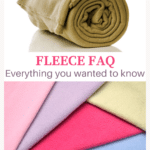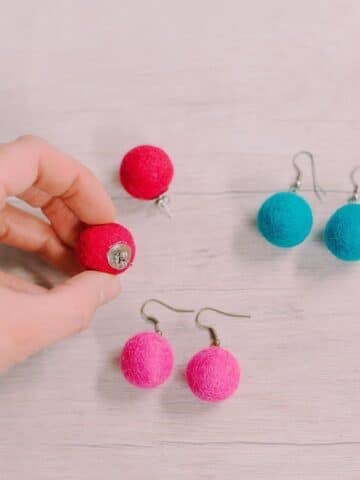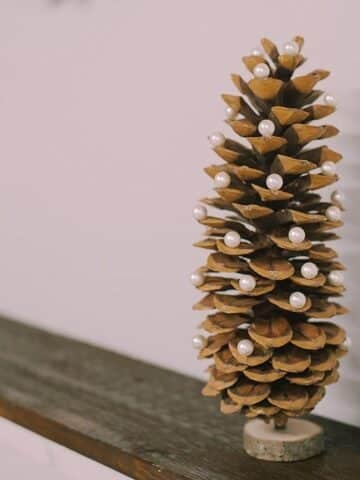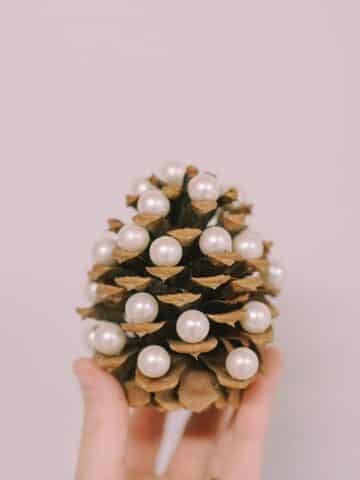A post about Fleece FAQ - everything you need to know about fleece fabric. Flannel vs fleece, can you iron fleece, how to sew fleece & more!
Are you ready to cozy up with some fleece fabric but don't know where to start? Fear not!
From its uses to the different types of fleece available, I've got you covered.
Plus, I've given you some tips on how to care for your fleece and how to sew with it like a pro.
You'll be ready for projects like a fleece tag blanket, a DIY fleece tie pillowcase, or how to make a fleece tie blanket.

What is Fleece Fabric?
Fleece is a synthetic material made from polyester.
It's designed to be soft, warm, and lightweight, making it a popular choice for cold weather items.
Fleece is often used for blankets, jackets, hats, and other warm clothing items.
Flannel vs Fleece: What's the Difference?
Flannel and fleece are two different fabrics that are often confused.
Flannel is a soft, lightweight fabric that's made from cotton or wool. It's often used for shirts, pajamas, and bedding.
Fleece, on the other hand, is a synthetic material made from polyester. It's thicker and warmer than flannel, and is commonly used for jackets, blankets, and other cold weather items.
What Are the Different Types of Fleece?
There are several different types of fleece, each with its own characteristics and uses.
Here are a few of the most common types:
Polar fleece: This is the most popular type of fleece. It's thick and warm, and has a fluffy texture that's similar to wool. Polar fleece is commonly used for jackets, blankets, and hats.
Microfleece: This is a lightweight and thin type of fleece that's ideal for layering. It's soft and comfortable, and is often used for athletic clothing and outdoor gear.
Sherpa fleece: This type of fleece has a fluffy and thick pile on one side, and a smooth backing on the other. It's commonly used for blankets and jackets.
What Can Fleece Be Used For?
Fleece is a versatile fabric that can be used for many different applications.
Here are a few ideas:
- Clothing: Fleece is commonly used for jackets, sweatshirts, and other warm clothing items.
- Blankets: Fleece blankets are soft and warm, and are perfect for snuggling up on the couch or keeping warm at night.
- Pet products: Fleece is often used for pet blankets, beds, and jackets.
- Home decor: Fleece can be used for a variety of home decor items, such as pillows, curtains, and tablecloths.
How to Wash Fleece
Fleece is easy to care for and requires minimal maintenance. Here are a few tips for washing fleece:
- Wash fleece in cold water to prevent shrinking and damage to the fabric.
- Use a gentle detergent, and avoid using fabric softener, which can damage the fabric.
- Hang fleece items to dry, or tumble dry on low heat.
Can You Iron Fleece?
No, you should not iron fleece. Fleece can melt and become damaged if exposed to high heat.
Instead, you can use a pressing cloth to smooth out any wrinkles in the fabric.
Is Fleece Warm?
Yes, fleece is warm and cozy. It's designed to trap heat close to the body, which makes it a popular choice for cold weather items like jackets and blankets.
How to Sew Fleece
Sewing and crafting with fleece is easy, even for beginners.
Here are a few tips to help you get started:
- Use the right needle: When sewing with fleece, it's important to use the right type of needle. A universal or ballpoint needle is best, as they are designed to prevent the fabric from stretching or puckering. A size 90/14 or 100/16 needle will work best for most fleece projects.
- Choose the right thread: When it comes to thread, a polyester all-purpose thread will work well with fleece. You can choose a color that matches your fabric or opt for a contrasting color for a fun look.
- Use a zigzag stitch: A zigzag stitch or stretch stitch is best for sewing fleece, as it will allow the fabric to stretch without breaking the stitches. Set your machine to a medium length and width for a good balance of strength and flexibility.
- Use a walking foot: A walking foot can be helpful when sewing fleece, as it will help to prevent the fabric from stretching or shifting as you sew. If you don't have a walking foot, you can try using a regular foot and placing tissue paper under the fabric to help it move more smoothly.
- Trim the seams: After sewing, trim the seam allowances to reduce bulk and make the finished project look neater. Be sure to leave enough seam allowance to keep the seam secure.
Fleece Projects to Try
Now that you know all about fleece, it's time to put your skills to the test!
Here are a few fun fleece projects to try:
- Patchwork Fleece Blanket: A fleece blanket is a classic project that's perfect for snuggling up on the couch or keeping warm at night. Simply cut pieces of fleece to your desired size, then sew them together along the edges using a zigzag stitch. You can also add fringe to the edges for a fun look.
- Fleece Scarf: A fleece scarf is another easy project that's perfect for beginners. Cut a piece of fleece to your desired length and width, then fold it in half and sew the edges together. You can also add fringe to the ends for a fun touch.
- Fleece Throw Pillow: A fleece throw pillow (like this DIY fleece tie pillowcase) is a cozy addition to any couch or bed. Cut two pieces of fleece to your desired size, then sew them together along three sides. Stuff the pillow with filling, then sew the fourth side closed. Keep the décor flexible by making your own envelope style pillow cases.
- - - - -
Fleece is a versatile and cozy fabric that's perfect for a wide range of projects.
Whether you're a beginner or an experienced sewist, there's always something new to learn and explore in the world of fleece.
So what are you waiting for? Dive into the cozy world of fleece and let the fun begin!









Leave a Reply